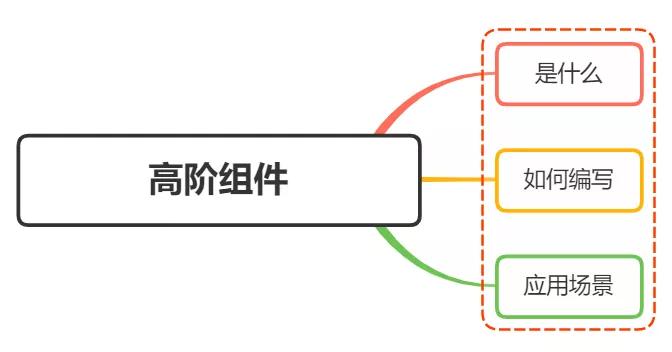本文转载自微信公众号「JS每日一题」,作者灰灰。转载本文请联系JS每日一题公众号。
一、是什么
高阶函数(Higher-order function),至少满足下列一个条件的函数
- 接受一个或多个函数作为输入
- 输出一个函数
在React中,高阶组件即接受一个或多个组件作为参数并且返回一个组件,本质也就是一个函数,并不是一个组件
- const EnhancedComponent = highOrderComponent(WrappedComponent);
上述代码中,该函数接受一个组件WrappedComponent作为参数,返回加工过的新组件EnhancedComponent
高阶组件的这种实现方式,本质上是一个装饰者设计模式
二、如何编写
最基本的高阶组件的编写模板如下:
- import React, { Component } from 'react';
- export default (WrappedComponent) => {
- return class EnhancedComponent extends Component {
- // do something
- render() {
- return <WrappedComponent />;
- }
- }
- }
通过对传入的原始组件 WrappedComponent 做一些你想要的操作(比如操作 props,提取 state,给原始组件包裹其他元素等),从而加工出想要的组件 EnhancedComponent
把通用的逻辑放在高阶组件中,对组件实现一致的处理,从而实现代码的复用
所以,高阶组件的主要功能是封装并分离组件的通用逻辑,让通用逻辑在组件间更好地被复用
但在使用高阶组件的同时,一般遵循一些约定,如下:
- props 保持一致
- 你不能在函数式(无状态)组件上使用 ref 属性,因为它没有实例
- 不要以任何方式改变原始组件 WrappedComponent
- 透传不相关 props 属性给被包裹的组件 WrappedComponent
- 不要再 render() 方法中使用高阶组件
- 使用 compose 组合高阶组件
- 包装显示名字以便于调试
这里需要注意的是,高阶组件可以传递所有的props,但是不能传递ref
如果向一个高阶组件添加refe引用,那么ref 指向的是最外层容器组件实例的,而不是被包裹的组件,如果需要传递refs的话,则使用React.forwardRef,如下:
- function withLogging(WrappedComponent) {
- class Enhance extends WrappedComponent {
- componentWillReceiveProps() {
- console.log('Current props', this.props);
- console.log('Next props', nextProps);
- }
- render() {
- const {forwardedRef, ...rest} = this.props;
- // 把 forwardedRef 赋值给 ref
- return <WrappedComponent {...rest} ref={forwardedRef} />;
- }
- };
- // React.forwardRef 方法会传入 props 和 ref 两个参数给其回调函数
- // 所以这边的 ref 是由 React.forwardRef 提供的
- function forwardRef(props, ref) {
- return <Enhance {...props} forwardRef={ref} />
- }
- return React.forwardRef(forwardRef);
- }
- const EnhancedComponent = withLogging(SomeComponent);
三、应用场景
通过上面的了解,高阶组件能够提高代码的复用性和灵活性,在实际应用中,常常用于与核心业务无关但又在多个模块使用的功能,如权限控制、日志记录、数据校验、异常处理、统计上报等
举个例子,存在一个组件,需要从缓存中获取数据,然后渲染。一般情况,我们会如下编写:
- import React, { Component } from 'react'
- class MyComponent extends Component {
- componentWillMount() {
- let data = localStorage.getItem('data');
- this.setState({data});
- }
- render() {
- return <div>{this.state.data}</div>
- }
- }
上述代码当然可以实现该功能,但是如果还有其他组件也有类似功能的时候,每个组件都需要重复写componentWillMount中的代码,这明显是冗杂的
下面就可以通过高价组件来进行改写,如下:
- import React, { Component } from 'react'
- function withPersistentData(WrappedComponent) {
- return class extends Component {
- componentWillMount() {
- let data = localStorage.getItem('data');
- this.setState({data});
- }
- render() {
- // 通过{...this.props} 把传递给当前组件的属性继续传递给被包装的组件WrappedComponent
- return <WrappedComponent data={this.state.data} {...this.props} />
- }
- }
- }
- class MyComponent2 extends Component {
- render() {
- return <div>{this.props.data}</div>
- }
- }
- const MyComponentWithPersistentData = withPersistentData(MyComponent2)
再比如组件渲染性能监控,如下:
- class Home extends React.Component {
- render() {
- return (<h1>Hello World.</h1>);
- }
- }
- function withTiming(WrappedComponent) {
- return class extends WrappedComponent {
- constructor(props) {
- super(props);
- this.start = 0;
- this.end = 0;
- }
- componentWillMount() {
- super.componentWillMount && super.componentWillMount();
- this.start = Date.now();
- }
- componentDidMount() {
- super.componentDidMount && super.componentDidMount();
- this.end = Date.now();
- console.log(`${WrappedComponent.name} 组件渲染时间为 ${this.end - this.start} ms`);
- }
- render() {
- return super.render();
- }
- };
- }
- export default withTiming(Home);
参考文献
https://zh-hans.reactjs.org/docs/higher-order-components.html#gatsby-focus-wrapper
https://zh.wikipedia.org/wiki/%E9%AB%98%E9%98%B6%E5%87%BD%E6%95%B0
https://segmentfault.com/a/1190000010307650
https://zhuanlan.zhihu.com/p/61711492


























